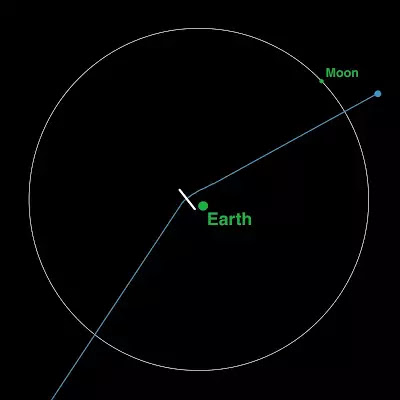There is going to be an asteroid passing close to the earth and will be visible with the naked eyes.
Until those determinations were made, it was the highest rating ever assigned on the Torino Impact Hazard Scale, reaching level 4 on December 27, 2004. The Torino scale is a method of categorizing the impact hazard associated with near-earth objects such as asteroids or comets. As of the latest estimate of its size, made in 2014, Apophis is estimated to have a diameter of 370 meters. It orbits the sun similarly to Earth but its year is a bit shorter at 324 days. On average, an asteroid of the size of Apophis hits earth every 80,000 years or so. A close approach like this happens, on average, every 1,000 years. The closest approach that Apophis will be making is going to be on April 13th, 2029. The asteroid will come within 31,000 km of the Earth's surface.This is about as close as you can get in astronomical terms. It's 10x closer than the moon and it's even closer than some of our satellites. Here's an illustration showing how close it'll get.
The blue line is the asteroid's path and it will avoid Earth and the Moon. The white line is the uncertainty associated with the calculation so it could be a little bit closer or a little bit further. This is close enough that the Earth's gravitational pull will change the asteroid's orbit enough that it'll be moved to a different category of near-earth asteroids, based on the new orbit.
For our friends in Europe, Africa, and western Asia, they'll be able to see it with the naked eye on that date where light pollution is a bit lower than cities. It could probably even be seen from cities but if you want to see it for yourself, it's probably best to go to a darker area away from the city. It'll be travelling faster than many satellites and it'll be brighter than most stars.
It probably won't have long-lasting global effects though like an impact winter where the sun's radiation would be blocked by the dust and ash propelled in the air by the impact. If it were to hit land, it would cause a crater of about 4.3 km wide. If it were to hit the Atlantic or Pacific oceans, it would create a tsunami with a destructive radius that depends on the coasts being hit. For North America, Brazil, and Africa, it would destroy everything inland within about 1,000 km. For Japan, it would be 3,000 km and for some areas of Hawaii, it would be around 4,500 km.
China is also planning an exploration fly-by mission in 2022 that would last a total of 6 years. It would include a close study of 3 asteroids by sending a probe to fly side by side with Apophis. It would study Apophis itself and it would land on the 1996 FG3 asteroid. The third one hasn't been announced yet. Up to now, the deflection strategies would include a few possibilities. NASA, ESA, various research groups, and the Planetary Society contest teams all described a number of different proposals including gravitational tractors, kinetic impacts, and nuclear bomb methods.
In 2009, Russia said they would study designs for a possible deflection mission to Apophis. In 2011, China proposed launching a mission to knock Apophis onto a safer course using an impactor spacecraft that would keep it away from the gravitational keyhole altogether. And in 2016, Russia announced their intentions to use some of their ICBMs to target relatively small near-earth objects between 20 to 50 meters in size. Even though Apophis is bigger than that, they said that it would be an object considered for testing by this program.
Up to now, no one in recorded history will have ever seen an asteroid in space so bright that it can be seen with the naked eye. So after all, what was supposed to be a very unlucky Friday the 13th might actually be the luckiest one in recorded history.
You may like:
What it is?
The asteroid was first discovered on June 19, 2004 by Roy A. Tucker, David J. Tholen, and Fabrizio Bernardi at the Kitt Peak National Observatory. It used to be known under its provisional designation, which was 2004 MN4, when it was first discovered. Once it was better known and its orbit was sufficiently well-calculated, it received the permanent number, 99942, on June 24, 2005. Receiving the permanent number made it eligible for naming by its discoverers and they ended up settling on the name "Apophis" after a villain in Stargate SG-1 that was considered one of the main threats to the existence of civilization on Earth, in the first few seasons. Apophis is a near-earth asteroid that caused a brief period of concern in December 2004 because it was calculated at about 2.7% chance of impacting Earth on April 13, 2029. It became pretty well-known at this point as a potentially very unlucky Friday the 13th.When and How it's supposed to happen?
Until 2006, we thought it was still a possibility that it would pass through what we call a gravitational keyhole; which are areas that will sufficiently change the orbit and set a near-earth object up for a future collision with Earth. In this particular case, the gravitational keyhole would be setting up Apophis to hit earth seven years later, in 2036. Further observations improved our predictions and we eliminated the possibility of an impact with earth or the moon in 2029 and it won't be going through the gravitational keyhole either.Until those determinations were made, it was the highest rating ever assigned on the Torino Impact Hazard Scale, reaching level 4 on December 27, 2004. The Torino scale is a method of categorizing the impact hazard associated with near-earth objects such as asteroids or comets. As of the latest estimate of its size, made in 2014, Apophis is estimated to have a diameter of 370 meters. It orbits the sun similarly to Earth but its year is a bit shorter at 324 days. On average, an asteroid of the size of Apophis hits earth every 80,000 years or so. A close approach like this happens, on average, every 1,000 years. The closest approach that Apophis will be making is going to be on April 13th, 2029. The asteroid will come within 31,000 km of the Earth's surface.This is about as close as you can get in astronomical terms. It's 10x closer than the moon and it's even closer than some of our satellites. Here's an illustration showing how close it'll get.
The blue line is the asteroid's path and it will avoid Earth and the Moon. The white line is the uncertainty associated with the calculation so it could be a little bit closer or a little bit further. This is close enough that the Earth's gravitational pull will change the asteroid's orbit enough that it'll be moved to a different category of near-earth asteroids, based on the new orbit.
For our friends in Europe, Africa, and western Asia, they'll be able to see it with the naked eye on that date where light pollution is a bit lower than cities. It could probably even be seen from cities but if you want to see it for yourself, it's probably best to go to a darker area away from the city. It'll be travelling faster than many satellites and it'll be brighter than most stars.
What if it hits the Earth?
As of 2016, our calculations only show that Apophis has a 1 in 150,000 chance of impacting Earth in 2068. It turns into a 1 in 110,000 chance of hitting Earth at any point between 2060 and 2105. If it does hit Earth, we expect that it'll hit with about 750 megatons of kinetic energy. For comparison, this is the Meteor Crater in Arizona and the impact that created it is estimated to be around the 10 megaton range. The biggest hydrogen bomb ever exploded was the Tsar Bomba at around 57 megatons and it created a mushroom cloud about 65 km high; which is 5 to 6 times the height of commercial airliners. Apophis would be around 15 times more powerful than the Tsar Bomb. The exact effects are not completely known though because a lot of it would depend on the asteroid's composition, the location of the impact, and the angle of the impact. What we do know is that it would be extremely detrimental to an area of thousands of square kilometers.It probably won't have long-lasting global effects though like an impact winter where the sun's radiation would be blocked by the dust and ash propelled in the air by the impact. If it were to hit land, it would cause a crater of about 4.3 km wide. If it were to hit the Atlantic or Pacific oceans, it would create a tsunami with a destructive radius that depends on the coasts being hit. For North America, Brazil, and Africa, it would destroy everything inland within about 1,000 km. For Japan, it would be 3,000 km and for some areas of Hawaii, it would be around 4,500 km.
What plans we have to deflect it?
In 2007, the Planetary Society organized a 50,000$ competition to design an unmanned space probe that would shadow Apophis for almost a year to take measurements. The goal would be to allow us to know more definitely if it could potentially impact Earth and if a deflection mission would be necessary to alter Apophis' orbit. The competition received 37 entries from 20 countries on 6 continents. The winner was Foresight which was created by Space Works Enterprises. They proposed a simple orbiter with only two instruments and a radio beacon at a cost of 140 million dollars. It would launch from Earth, arrive at Apophis 5 to 10 months later, then it would orbit the asteroid for one month, afterwards it would leave orbit and fly in formation with Apophis around the Sun at a range of 2 km, and it would continue to gather data for 10 months about the movements of the asteroid so we can more accurately determine the asteroid's orbit and how it might change.China is also planning an exploration fly-by mission in 2022 that would last a total of 6 years. It would include a close study of 3 asteroids by sending a probe to fly side by side with Apophis. It would study Apophis itself and it would land on the 1996 FG3 asteroid. The third one hasn't been announced yet. Up to now, the deflection strategies would include a few possibilities. NASA, ESA, various research groups, and the Planetary Society contest teams all described a number of different proposals including gravitational tractors, kinetic impacts, and nuclear bomb methods.
In 2009, Russia said they would study designs for a possible deflection mission to Apophis. In 2011, China proposed launching a mission to knock Apophis onto a safer course using an impactor spacecraft that would keep it away from the gravitational keyhole altogether. And in 2016, Russia announced their intentions to use some of their ICBMs to target relatively small near-earth objects between 20 to 50 meters in size. Even though Apophis is bigger than that, they said that it would be an object considered for testing by this program.
Up to now, no one in recorded history will have ever seen an asteroid in space so bright that it can be seen with the naked eye. So after all, what was supposed to be a very unlucky Friday the 13th might actually be the luckiest one in recorded history.
You may like:













0 Comments